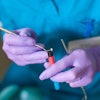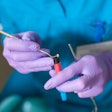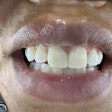Although it seems counterintuitive, a bone break can lead to a stronger bone that can support an oral implant, according to a case report published in the Journal of Oral Implantology (October 2012, Vol. 38:5, pp. 611-616).
Introducing microcracks into the mandible stimulates bone growth, according to the study authors. And greater bone density can lead to more successful placement of oral implants and dental prostheses.
The report describes an approach to oral implant surgery for patients with severely atrophic jaws that stimulates bone activation of the future implant location. More complicated procedures such bone grafts and sinus lifts have met with success, but are not always desirable, the researchers noted.
Dental patients with severely atrophic jaws have poor quality and quantity of bone in which to place an implant. The Osteotensor, a purpose-designed instrument, can be used to create a series of microcracks in the mandible. A biological response then takes place, with proteins, stem cells, and other growth factors working to regenerate the bone.
After 45 to 90 days, implant surgery can take place. Solid titanium disks are implanted into the bone bed and covered by biomaterial. A rigid, screw-fixed prosthesis can then be immediately loaded and become functional.
In this case, a 74-year-old woman was treated with this technique after she declined to undergo a bone grafting procedure. Forty-five days after microcracks induced bone activation, the same Osteotensor instrument could no longer penetrate bone at 23 of 42 impact sites. After 90 days, none of the sites could be penetrated. Softer, type IV bone had been transformed to harder, type II bone, and it was safe to proceed with implant surgery.
Two years later, the patient's implants were osseointegrated, and the regenerated bone had become functional bone, according to the authors.



















